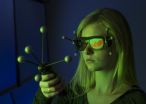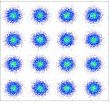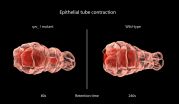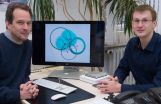(Press-News.org) It's like a scene from a gamer's wildest dreams: 12 high-definition, 55-inch 3D televisions all connected to a computer capable of supporting high-end, graphics-intensive gaming.
On the massive screen, images are controlled by a Wii remote that interacts with a Kinnect-like Bluetooth device (called SmartTrack), while 3D glasses worn by the user create dizzying added dimensions.
But this real-life, computer-powered mega TV is not for gaming. It's for engineering.
Welcome to Brigham Young University's VuePod, a 3D immersive visualization environment run by BYU's Department of Civil and Environmental Engineering. Student-built and operated, under the supervision of civil engineering professor Dan Ames, the VuePod is changing the way engineers are viewing environmental engineering challenges.
"This is gold," said fellow BYU civil engineering professor Kevin Franke. "This technology has the ability to revolutionize my job as an earthquake engineer."
That's because the VuePod allows users to virtually fly over, wander through or hover above 3D environments that are otherwise difficult to visit. The images are created by point data from aircraft equipped with LIDAR (think RADAR, but with lasers). The LIDAR scans the landscape and records millions of data points that are then viewed as an image on the VuePod. Point data can also be created from stitched-together photographs taken from low-cost drones, which is Franke's research focus.
One set of data currently available for study in the VuePod captured a canyon area beneath a plateau in southern Idaho. With 3D glasses and the Wii controller, a user can virtually drop down into the canyon from above, and then fly from one end to the other.
As cool as it is to fly through a canyon, the real engineering application comes in when you combine two sets of data for the same canyon, taken five years a part. With the second set of data, changes in the natural landscape that are invisible to the human eye become clear as day. Thanks to the VuePod's massive 108-square-foot screen, all of the image-making data can be presented for viewing.
"Our eyes and our brains are so amazing; we need to take full advantage of them," Ames said. "That's the value of this project: we're presenting more information for the human eyes to detect changes."
In addition to natural change detection, the VuePod has the potential to assist in infrastructure monitoring--such as tracking how highways hold up (or slough and crack) over time and seeing the affect on buildings after severe weather or earthquakes.
While the VuePod is certainly not the first immersive visualization system in academia, it may just be the most cost efficient built to date. Some systems cost as much as $10 million to build and maintain, while BYU's VuePod just barely topped the $30,000 mark.
Ames details how BYU was able to build such a powerful system for so little in a new paper published by the Journal of Computing in Civil Engineering.
"Our question has been: How can we make this technology accessible?" Ames said. "We're trying to determine the threshold for getting the most function at the most affordable cost. Ultimately, the goal is to take an expensive tool and make it cheaper for an everyday engineering firm to use."
And even though Ames and his students have achieved that, they believe much more can be done.
"We want whoever reads this paper to be able to build a better system than we built," he said.
INFORMATION:
New research indicates that reducing emergency surgery for three common procedures by 10 percent could cut $1 billion in health care costs over 10 years.
As hospitals and health systems increasingly focus on addressing the rising cost of health care in the United States, and with the expense of surgical care playing a major role, physician researchers and others across the healthcare industry are working to identify innovative ways to reduce surgical costs.
In new findings published online in the journal Annals of Surgery on December 19, 2014, researchers determined ...
Researchers from the University of Southampton have revealed a breakthrough in optical fibre communications.
Academics from the University's Optoelectronics Research Centre (ORC) have collaborated with colleagues at Eblana Photonics Inc, in Ireland, to develop an approach that enables direct modulation of laser currents to be used to generate highly advanced modulation format signals.
The research, published in the journal Nature Communications, explores a radically new approach to the generation of spectrally-efficient advanced modulation format signals as required ...
Carnivorous plants catch and digest tiny animals in order and derive benefits for their nutrition. Interestingly the trend towards vegetarianism seems to overcome carnivorous plants as well. The aquatic carnivorous bladderwort, which can be found in many lakes and ponds worldwide, does not only gain profit from eating little animals but also by consuming algae and pollen grains. This results in survival in aquatic habitats where prey animals are rare, and in increased fitness if the animals and algae are caught in a well-balanced diet. An Austrian research group around ...
Researchers at the Mechanobiology Institute (MBI), National University of Singapore (NUS) have identified a novel mechanosensitive regulation of epithelial tube contraction. These findings are published on 19 December 2014 in Current Biology (Pei Yi Tan and Ronen Zaidel-Bar. Transient membrane localization of SPV-1 drives cyclical actomyosin contractions in the C. elegans spermatheca, Current Biology, 19 Dec 2014, doi: 10.1016/j.cub.2014.11.033)
Regulating tube constriction
Many of the fundamental processes of life rely on biological structures known as epithelial ...
Over the past decade, ocean acidification has received growing recognition not only in the scientific area. Decision-makers, stakeholders, and the general public are becoming increasingly aware of "the other carbon dioxide problem". It is time to reflect on the successes and deficiencies of ocean acidification research and to take a look forward at the challenges the fastest growing field of marine science is facing. In the January issue of the journal Nature Climate Change Ulf Riebesell, professor for Biological Oceanography at GEOMAR Helmholtz Centre for Ocean Research ...
Bremerhaven/Germany, 18 December 2014. Ingestion of microplastic particles does not mechanically affect marine isopods. This was the result of a study by biologists at the North Sea Office of the Alfred Wegener Institute, Helmholtz Centre for Polar and Marine Research (AWI) that was published recently in the journal Environmental Science and Technology. The study marks the launch of a series of investigations aimed at forming a risk matrix on the sensitivity of different marine species to microplastic pollution.
Uptake of large plastic items by birds and fish may cause ...
In a recent study from Lund University in Sweden, researchers have used new technology to study extremely fast processes in solar cells. The research results form a concrete step towards more efficient solar cells.
The upper limit for the efficiency of normal solar cells is around 33 per cent. However, researchers now see a possibility to raise that limit to over 40 per cent, thereby significantly improving the potential of this energy source.
The experiments in the present study involved 'juggling' on quantum level with photons, i.e. light particles, and electrons. ...
In everyday life, the global positioning system (GPS) can be employed to reliably determine the momentary location of one en route to the desired destination. Scientists from the Institute of Physical and Theoretical Chemistry of the University of Bonn have now developed a molecular "GPS" with which the whereabouts of metal ions in enzymes can be reliably determined. Such ions play important roles in all corners of metabolism and synthesis for biological products. The "molecular GPS" is now being featured in the journal Angewandte Chemie.
There would be no life on our ...
Bethesda, MD (Dec. 19, 2014) -- A new formulation of oral budesonide suspension, a steroid-based treatment, is safe and effective in treating pediatric patients with eosinophilic esophagitis (EoE), according to a new study in Clinical Gastroenterology and Hepatology, the official clinical practice journal of the American Gastroenterological Association. Eosinophilic esophagitis is a chronic immune system disease caused by a buildup of white blood cells in the lining of the esophagus. This build up, which is a reaction to food, allergens or acid reflux, can inflame or injure ...
The changes can be measured, but their reasons were unknown. For several decades, scientists have carefully observed that the oxygen minimum zones (OMZ) in the tropical oceans are expanding. These zones are a paradise for some specially adapted microorganisms, but for all larger marine organisms such as fish and marine mammals they are uninhabitable. Thus, their expansion has already narrowed down the habitat of some fish species.
Marine scientists from the GEOMAR Helmholtz Centre for Ocean Research Kiel and the Kiel Collaborative Research Centre (Sonderforschungsbereich, ...




